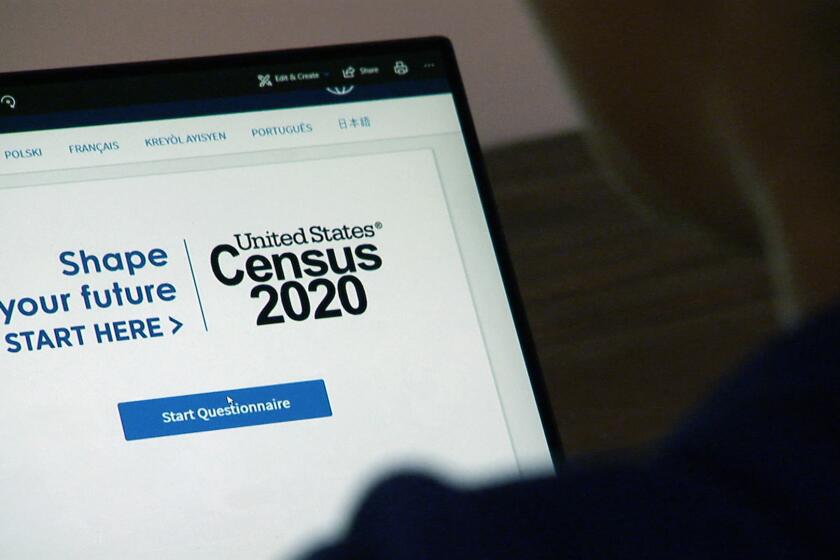Op-Ed: We have one last chance to get the census right, if the White House lets us
- Share via
The United States has one last chance to get the 2020 census right. It’s not looking good.
Delayed for months because of COVID-19, census workers will at last venture out in person in Los Angeles starting Tuesday. They’ll knock on doors at homes whose inhabitants have not yet been counted by phone, online or mail.
These households tend to be in poorer, heavily immigrant, Latino neighborhoods. If the enumerators fail to get responses — and it is all but certain many will — communities already reeling disproportionately from the pandemic will lose big. The census determines representation in Congress, and how the government divvies up more than $1.5 trillion a year in federal funds for schools, hospitals and other public services.
The “self-reporting” part of the 2020 census began in mid-March, when almost all U.S. households received a letter with instructions on how to provide the necessary information online. The in-person work was supposed to start in April, but the pandemic delayed it until July in a few areas and now August. The Trump administration extended the count’s final deadline from midsummer to Oct. 31. On Monday, however, the White House reneged: The new cutoff would be Sept. 30, a full four weeks earlier.
Four former Census Bureau directors issued a statement: The new cutoff would “result in seriously incomplete enumerations.” The bureau “needs the additional time to complete a high-quality census,” Nancy Potok, who recently retired as the chief statistician of the United States, told National Public Radio. “There is no reason not to extend the deadline unless you are trying to embed an undercount of certain groups of people.”
Last spring, as part of a journalism class at Cal State Northridge, my students set out to track the decennial census push across Southern California. The challenges to an equitable count were immense. Households without internet access were at a disadvantage. President Trump‘s attempt to add a citizenship question failed, but the threat alone added to the difficulty in getting immigrants to participate. And all of that came before COVID-19 surged and civil unrest unfolded.
Only 63% of the nation’s estimated 121 million households have responded to the 2020 Census by mail or phone or online.
As the government began reporting response rates to census questionnaires, my students quickly saw a trend taking hold: Residents in wealthier, predominantly white and Asian neighborhoods were filling out the census online, approaching rates of 10 years ago or sometimes even higher. (With one surprising exception — we tracked pockets of low response rates on the Westside, perhaps due to colleges closing, people escaping to vacation homes or lack of outreach.)
In poorer, predominantly Latino and Black neighborhoods, residents were responding at lower rates than a decade ago, despite record investment in outreach from the state. Our observations were confirmed in a study released in May from the UCLA Center for Neighborhood Knowledge documenting how the gap widened.
Today, fewer than half of Pacoima’s residents, for example, have responded to the census, at rates about 25 percentage points lower than a decade ago, even though they have had more time to fill out the form because of the lockdown. Meanwhile, a couple of miles down the 118 Freeway in much wealthier Porter Ranch, roughly 80% of households have participated.
“It was really fast,” Porter Ranch resident Karen Klein told Christopher Torres of the process. “I don’t even remember, because frankly it just wasn’t very memorable. It was so easy and quick and it just asks for really general information.”
Nationwide, census response rates stand at 63%, 3.5 points below what they were 10 years ago at the same time. (California is one point ahead of the national rate, at 64%) But as the in-person count begins here, in some L.A. neighborhoods the response rate is half that. And, not surprisingly, in places where the coronavirus has hit the hardest, participation rates are among the lowest.
Immigrants have always been reticent to respond, Thelma Gutierrez, who works for the census in the Canoga Park area, told Nick Martinez. “They think that the government wants to target them if they do the census, which is not true.”
Census organizers saw the rich-poor, white-nonwhite, immigrant-nonimmigrant divide coming and the state set aside $187.2 million for outreach. An enthusiastic and creative campaign included a South Central torta stand that offered census reminders along with the salsa and sandwiches, Instagram and TikTok influencers posting public service announcements, and young Latinos recruited to assist their elders as they delivered pandemic food boxes. There was even a #BigFatArmenianFamily social media challenge.
But COVID-19 interfered again. Libraries, where computer kiosks with instructions to complete the form in 14 languages were going to be set up, had to close. Still, the outreach had an impact. Christian Rubio got a voicemail reminder to participate, he told Martinez, and he also saw ads about it “every 10 minutes on TV and YouTube.” He finally helped his family fill in the form online because, he said, “I thought I was going to get fined or something.”
Every 10 years, Washington is constitutionally mandated to count “the whole number of persons” in the U.S.; doing it accurately is the basis of an equitable society. When enumerators begin knocking on doors in L.A. next week, it will be our last stand for fair representation. They need more time.
If the census deadline isn’t reset, the injustice will reverberate for at least a decade.
Daniela Gerson is an assistant professor of journalism at Cal State Northridge and cofounder of the newsletter Migratory Notes.
More to Read
Updates
9:24 a.m. Aug. 6, 2020: An earlier version of this piece misstated the date of the new census deadline. It is Sept. 30, not Sept. 31.
A cure for the common opinion
Get thought-provoking perspectives with our weekly newsletter.
You may occasionally receive promotional content from the Los Angeles Times.











